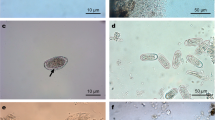Abstract
A coprological survey of gastrointestinal parasites in wild Japanese macaques (Macaca fuscata), from 14 natural habitats was done. Ova of five nematode species (Trichuris trichiura, Strongyloides fuelleborni, Streptopharagus pigmentatus, Oesophagostomum aculeatum, andGongylonema species) and a worm of the cestode species,Bertiella studieri, were detected. Some differences found in rates of infection by sex were observed in the 14 areas. Differences based on age were found in only troops in which the infection rates ofStrongyloides fuelleborni, Streptopharagus pigmentatus, andTrichuris trichiura were higher in the juvenile monkeys. The number of parasite species was related to the geographical and climatic conditions of the habitat of the troop: troops living in areas cold in winter were infected by fewer parasite species than those in southern warmer areas.
Similar content being viewed by others
References
Eduardo, S. L.;Castro, J. T. 1988. Some helminth parasites of the Philippine monkey,Macaca philippinesis.Phil. J. Vet. Med., 25: 15–21.
Gotoh, S. 1989. On the parasite infection of monkeys of Hakusan troop.Hakusan, 16: 9.
Hayama, S.;Nigi, H. 1963. Investigation on the helminth parasites in Japan Monkey Centre during 1959–1961.Primates, 4(1): 97–112.
Honjo, S.;Muto, K.;Fujiwara, T.;Suzuki, Y.;Imaizumi, K. 1963. Statistical survey of intestinal parasites in cynomolgus monkeys (Macaca irus).Jap. J. Med. Sci. Biol., 16: 217–224.
Horii, Y.;Imada, I.;Yanagida, T.;Usui, M.;Mori, A. 1982. Parasite changes and their influence on the body weight of Japanese monkeys (Macaca fuscata fuscata) of Koshima troop.Primates, 23: 416–431.
Itoh, K.;Oku, Y.;Okamoto, M.;Ohbayashi, M.;Kitamura, Y.;Shibahara, T. 1988. Helminth parasites of the Japanese monkey,Macaca fuscata fuscata in Ehime Prefecture, Japan.Jpn. J. Vet. Res., 36: 235–247.
Iwano, T. 1983. Natural environment and fauna of mammals in Yakushima Island.Nihonzaru (Japanese Monkeys), 5: 3–6. (in Japanese)
Japan Meteorological Agency. 1998.Weather Database “AMEDAS”. Index Company, Tokyo. (CD-ROM in Japanese).
Jessee, M. T.;Schilling, P. W.;Stunkard, J. A. 1970. Identification of intestinal helminth eggs in Old World primates.Lab. Anim. Care, 20: 83–87.
Kagei, N.;Hasegawa, H. 1974. On the fecal examination against helminthic-ova of the Japanese monkeys,Macaca fuscata (Blyth, 1875), from Takasakiyama, Oita Prefecture.Bull. Inst. Publ. Health, 23: 234–238. (in Japanese)
Karr, S. L. Jr.;Henrickson, R. V.;Else, J. G. 1980. A survey for intestinal helminths in recentlyMacaca mulatta and results of treatment with mebendazole and thiabendazole.J. Med. Primatol., 9: 200–204.
Kawanabe, M.;Nojima, H.;Uchikawa, R. 1988. Tansmammary transmission of Strongyloides ratti.Parasitol. Res., 75: 50–56.
Kessler, M. J.;Yarbrough, B.;Rawlins, R. G.;Berard, J. 1984. Intestinal parasites of the free-ranging Cayo Santiago Rhesus monkeys (Macaca mulatta).J. Med. Primatol., 13: 57–66.
Kuntz, R. E.;Myers, B. J. 1969. A checklist of parasites and commensals reported for the Taiwan macaque (Macaca cyclopisSwinhoe, 1862).Primates, 10: 71–80.
Machida, M.;Araki, J.;Koyama, T.;Kumada, M.;Horii, Y.;Imada, I.;Takasaka, M.;Honjo, S.;Matsubayashi, K.;Tiba, T. 1978. The life cycle ofStreptopharagus pigmentatus (Nematoda, Spiruroidea) from the Japanese monkey.Bull. Natn. Sci. Mus., Ser. A (Zool.) 4: 1–9.
Matsubayashi, K.;Gotoh, S.;Kawamoto, Y.;Nozawa, K.;Suzuki, J. 1989. Biological characteristics of crab-eating monkeys on Angaur Island.Primate Res., 5: 46–57.
Matsubayashi, K.;Gotoh, S.;Kawamoto, Y.;Watanabe, T.;Nozawa, K.;Takasaka, M.;Narita, T.;Griffiths, O.;Stanley, M. A. 1992. Clinical examinatins on crab-eating macaques in Mauritius.Primates, 33: 281–288.
Nigi, H. 1982. On the infectious diseases. In:Nihonzaru, Sei no Seiri (Japanese Macaque: Physiology of Sex), Doubutsusha, Tokyo, pp. 248–255. (in Japanese).
Nigi, H.;Matsubayashi, K.;Machida, M. 1975. Clinical examinations of Japanese monkeys (Macaca fuscata) in Shiga-A troop.Physiol. Ecol., 16: 35–46. (in Japanese)
Okada, M. 1975. Local cold tolerance of Japanese macaques of Shiga-A troop as seen from finger skin temperature.Physiol. Ecol., 16: 15–21 (in Japanese)
Takada, H.;Huang, W. H.;Fujita, H. 1981. Parasitological survey of the most northern monkey population (The Japanese monkey:Macaca fuscata) in the world.Hirosaki Igaku, 33: 67–76. (in Japanese)
Uni, S.;Abe, M.;Harada, K.;Kaneda, K.;Kimata, I.;Abdelmaksoud, N. M.;Takahashi, K.;Miyashita, M.;Iseki, M. 1992. New record ofGongylonema pulchrumMolin, 1857 from a new host,Macaca fuscta, in Japan.Ann. Parasitol. Human Comp., 67: 221–223.
Uni, S.;Kobayashi, S.;Miyashita, M.;Kimura, N.;Kato, A.;Aimi, M.;Kimata, I.;Iseki, M.;Shono, C. 1994. Geographic distribution ofGongylonema pulchrum andGongylonema macrogubernaculum fromMacaca fuscata in Japan.Parasite, 1: 127–130.
Usui, M.;Horii, Y. 1982. A survey on helminth parasites of the Japanese monkey (Macaca fuscata).Bull. Fac. Agri. Miyazaki Univ., 29: 269–274. (in Japanese)
Wong, M. M.;Conrad, H. D. 1978. Prevalence of metaxoan parasite infections in five species of Asian macaques.Lab. Anim. Sci., 28: 412–416.
Author information
Authors and Affiliations
About this article
Cite this article
Gotoh, S. Regional differences in the infection of wild Japanese macaques by gastrointestinal helminth parasites. Primates 41, 291–298 (2000). https://doi.org/10.1007/BF02557598
Received:
Accepted:
Issue Date:
DOI: https://doi.org/10.1007/BF02557598




